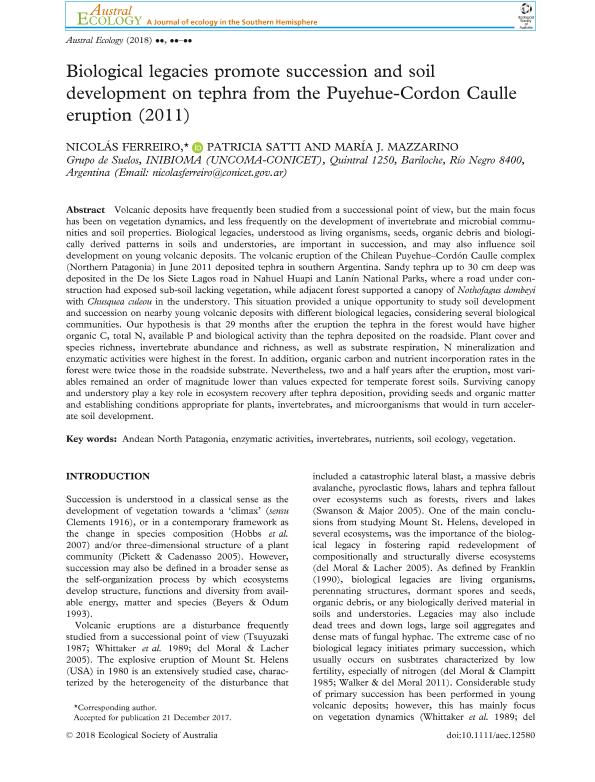Mostrar el registro sencillo del ítem
dc.contributor.author
Ferreiro, Nicolas Andres

dc.contributor.author
Satti, Patricia

dc.contributor.author
Mazzarino, Maria Julia

dc.date.available
2018-11-13T18:19:52Z
dc.date.issued
2018-06-06
dc.identifier.citation
Ferreiro, Nicolas Andres; Satti, Patricia; Mazzarino, Maria Julia; Biological legacies promote succession and soil development on tephra from the Puyehue-Cordon Caulle eruption (2011); Wiley Blackwell Publishing, Inc; Austral Ecology; 43; 4; 6-6-2018; 435-446
dc.identifier.issn
1442-9985
dc.identifier.uri
http://hdl.handle.net/11336/64357
dc.description.abstract
Volcanic deposits have frequently been studied from a successional point of view, but the main focus has been on vegetation dynamics, and less frequently on the development of invertebrate and microbial communities and soil properties. Biological legacies, understood as living organisms, seeds, organic debris and biologically derived patterns in soils and understories, are important in succession, and may also influence soil development on young volcanic deposits. The volcanic eruption of the Chilean Puyehue–Cordón Caulle complex (Northern Patagonia) in June 2011 deposited tephra in southern Argentina. Sandy tephra up to 30 cm deep was deposited in the De los Siete Lagos road in Nahuel Huapi and Lanín National Parks, where a road under construction had exposed sub-soil lacking vegetation, while adjacent forest supported a canopy of Nothofagus dombeyi with Chusquea culeou in the understory. This situation provided a unique opportunity to study soil development and succession on nearby young volcanic deposits with different biological legacies, considering several biological communities. Our hypothesis is that 29 months after the eruption the tephra in the forest would have higher organic C, total N, available P and biological activity than the tephra deposited on the roadside. Plant cover and species richness, invertebrate abundance and richness, as well as substrate respiration, N mineralization and enzymatic activities were highest in the forest. In addition, organic carbon and nutrient incorporation rates in the forest were twice those in the roadside substrate. Nevertheless, two and a half years after the eruption, most variables remained an order of magnitude lower than values expected for temperate forest soils. Surviving canopy and understory play a key role in ecosystem recovery after tephra deposition, providing seeds and organic matter and establishing conditions appropriate for plants, invertebrates, and microorganisms that would in turn accelerate soil development.
dc.format
application/pdf
dc.language.iso
eng
dc.publisher
Wiley Blackwell Publishing, Inc

dc.rights
info:eu-repo/semantics/openAccess
dc.rights.uri
https://creativecommons.org/licenses/by-nc-sa/2.5/ar/
dc.subject
Andean North Patagonia
dc.subject
Enzymatic Activities
dc.subject
Invertebrates
dc.subject
Nutrients
dc.subject
Soil Ecology
dc.subject
Vegetation
dc.subject.classification
Otras Ciencias Biológicas

dc.subject.classification
Ciencias Biológicas

dc.subject.classification
CIENCIAS NATURALES Y EXACTAS

dc.title
Biological legacies promote succession and soil development on tephra from the Puyehue-Cordon Caulle eruption (2011)
dc.type
info:eu-repo/semantics/article
dc.type
info:ar-repo/semantics/artículo
dc.type
info:eu-repo/semantics/publishedVersion
dc.date.updated
2018-10-23T16:18:09Z
dc.journal.volume
43
dc.journal.number
4
dc.journal.pagination
435-446
dc.journal.pais
Reino Unido

dc.journal.ciudad
Londres
dc.description.fil
Fil: Ferreiro, Nicolas Andres. Consejo Nacional de Investigaciones Científicas y Técnicas. Centro Científico Tecnológico Conicet - Patagonia Norte. Instituto de Investigaciones en Biodiversidad y Medioambiente. Universidad Nacional del Comahue. Centro Regional Universidad Bariloche. Instituto de Investigaciones en Biodiversidad y Medioambiente; Argentina
dc.description.fil
Fil: Satti, Patricia. Consejo Nacional de Investigaciones Científicas y Técnicas. Centro Científico Tecnológico Conicet - Patagonia Norte. Instituto de Investigaciones en Biodiversidad y Medioambiente. Universidad Nacional del Comahue. Centro Regional Universidad Bariloche. Instituto de Investigaciones en Biodiversidad y Medioambiente; Argentina
dc.description.fil
Fil: Mazzarino, Maria Julia. Consejo Nacional de Investigaciones Científicas y Técnicas. Centro Científico Tecnológico Conicet - Patagonia Norte. Instituto de Investigaciones en Biodiversidad y Medioambiente. Universidad Nacional del Comahue. Centro Regional Universidad Bariloche. Instituto de Investigaciones en Biodiversidad y Medioambiente; Argentina
dc.journal.title
Austral Ecology

dc.relation.alternativeid
info:eu-repo/semantics/altIdentifier/doi/http://dx.doi.org/10.1111/aec.12580
dc.relation.alternativeid
info:eu-repo/semantics/altIdentifier/url/https://onlinelibrary.wiley.com/doi/abs/10.1111/aec.12580
Archivos asociados
